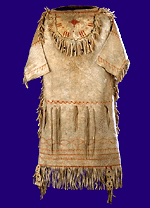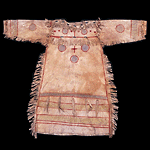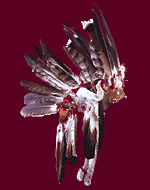 |
Dress; NLaka'pamux, acquired 1915; skin, glass beads, paint, sinew, cotton. CMC II-C-626
In traditional society of the NLaka'pamux (British Columbia interior) the choice of apparel and its quality depended on the day's activities, the family's wealth and the seamstresses' skills. The choice of decoration expressed personal messages of artistry, social position and dreams.
Through the paintings on their clothing, people communicated information about themselves. Nonetheless, the images sometimes referred to religious experiences that were private and personal. Earth lines, straight lines of red ochre drawn along seams, are a symbol of good luck. The morning star is usually represented by a cross. These designs were frequently drawn on garments.
|
 |
Young woman's dress; NLaka'pamux, acquired 1915; buckskin, glass beads, paint, sinew. CMC II-C-608
The designs on the front of the dress at left are a red earth line, with bands of yellow grass (or the surface of the ground) and the blue sky above. The blue circles are clouds, red dots are stars, and the red cross is the sun.
|
 |
The NLaka'pamux were master weavers who produced fine garments of elegant design. Woven clothing was used as a replacement when buckskin was scarce, in hot or rainy weather and was worn on certain ritual or ceremonial occasions.
Cape; NLaka'pamux, acquired 1928; silver-willow bark, buckskin, paint.
CMC II-C-614
Woven capes were also painted with symbolic or dream imagery.
|
 |
Hats and headdresses were the most visible and, at times, the only indication of an individual's status. Materials and decoration ranged from simple winter fur hats to elaborate headdresses of feathers and beads for ceremonial occasions.
Headdress; NLaka'pamux, acquired 1913; moose hair, wool, eagle feathers, bast, glass beads, fur. CMC II-C-200
|

![]()

![]()